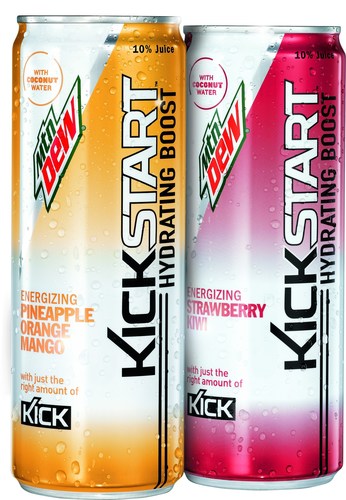
Following on one of their most successful drink launches in recent memory, Mountain Dew has added two additional offerings under their Kickstart drink portfolio. The Kickstart offshoot started to segment drinks by dayparts in 2013 and brought out two beverages targeting morning consumption. In 2014 they followed on the morning drinks with two more flavors catered toward evening occasions. Their most recent offerings – Pineapple Orange Mango and Strawberry Kiwi – are infused with coconut water (full press release found here), but does not overtly fit an actual drinking occasion. This makes the latest launch appear off strategy because it’s not geared specifically toward the morning, afternoon, or evening. How do these two drinks fit into the Kickstart portfolio? What is the purpose of this launch?
The “fit” debate may very well go back to the purpose of coconut water. Coconut water was targeted as a healthier alternative to sports drinks like Gatorade and Powerade. On an equivalized volume comparison, coconut water contains similar amounts of electrolytes but fewer calories and sodium, making it a strong substitute for the sports drinks marketed toward fitness-oriented consumers. In essence standalone coconut water is meant for hydration and recovery purposes. When mixed with Mountain Dew’s caffeinated citrus sodas, these drinks could be positioned as competition to sports drinks. A lightly carbonated energy drinks – with juice flavors and coconut water – can be termed as a hydration drink to compete with the Gatorades and Powerades out there. These latest release of Mountain Dew Kickstart would not need to fit under a daypart segmentation. It could be a morning drink for people that exercise in the morning, or it could also serve an evening recovery drink after workout or recreational sports.

If this is Mountain Dew Kickstart’s positioning around the new offerings, the only challenge would be where caffeine fits into the equation. Sports drinks are supposed to replenish what the body loses during sport events (electrolytes, sugars, salts, liquids) and caffeine would not fall under this criteria. While the body may craves some energy following an intense workout, it could be debated that the workout itself provides energy as a result of the activities. Caffeinated sports drinks may not be detrimental like alcoholic energy drinks but it’s relevance is questionable due to the caffeine. This may ultimately be an attempt to expand the Mountain Dew masterbrand beyond soda and energy drinks by reaching toward athletic consumers.
Or is it?
This brings us to the purpose of launching these two flavors of Mountain Dew Kickstart. Bevnet’s Neil Martinez-Belkin suggested this launch had more to do with creating success for O.N.E coconut water brand than extending Mountain Dew’s reach (article link here). Martinez-Belkin reminds us that months ago PepsiCo expressed intentions to include coconut water as an ingredient across multiple lines of business. Driving Kickstart infused with coconut water is simply a method of increasing coconut water;s public exposure. It may be because after buying O.N.E. coconut water that the beverage brand is still lacking robust market exposure. This make senses given both Coca-Cola and Pepsi – owners of ZICO and O.N.E – have re-deployed efforts to focus on their core business: carbonated soda. Marrying a powerhouse brand like Mountain Dew with coconut water increases coconut water’s consumer relevance without having to fully invest behind coconut water as a beverage brand. This is not to say that Pepsi may not be supporting O.N.E. coconut water in the future, it just means they are looking for creative options to build up the coconut water segment.
The Mountain Dew Kickstart launch raises a few eyebrows though it helps coconut water more than it appears in the public eye. For a global beverage manufacturer where many products fighting to keep their budgets, this is a creative way to grow a business that may be losing the fight to maintain funding against other beverages in Pepsi’s portfolio. O.N.E. coconut water would justify increased budgets if these two new Kickstart flavors sold well. And if this experiment is a hit between Mountain Dew and coconut water, we could see Tropicana infused with coconut water or even Pepsi cola infused with coconut water in a few years. If that does happen, you can point to the success of Mountain Dew, which has been one of Pepsi’s increasingly consumed soda brands despite the overall declines in soda.














